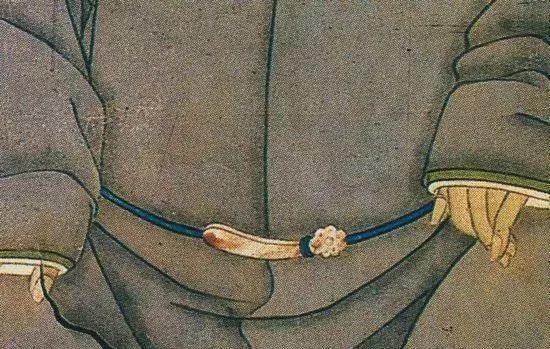The belt connected by a hook is a unique invention of ancient China and one of the longest and longest-lasting belt styles in traditional Chinese clothing.

The belt hook is the hook of the belt worn by the ancient nobles and literati warriors, and it is also known as "Rhinobi" in ancient times. Mostly cast in bronze, but also made of gold, silver, iron, jade and so on.
From the Western Zhou Dynasty to the Han and Jin Dynasties, in the costumes of male nobles, the belt was mainly tied with a hook, the so-called "belt about its (waist), hook hanging on the belt". The hook is a status symbol, and the material used in the hook, the degree of production fineness, the shape of the ornament and the size are the criteria for judging the value of the hook.
Song white jade carved pine deer pattern belt ornamentation
Slightly flattened rectangular, the front is slightly curved and convex, and the picture of Songxi Shuanglu is depicted by multi-layer carving techniques, and the picture is dense and compact, with clear primary and secondary. It is worth noting that this device is quite exquisite in the grinding of the lower ornament, which is incomparable to many similar works. The back is a four-sided thick frame with rectangular perforations on the sides for leather piercing. There is an oval ring in the lower part, which can be attached to the object.
White jade five bats hold shou buckle
Roughly in the Northern Dynasty era, the belt "weed belt", which is basically the same as the style of today's belt, rose and became the most mainstream style. The hooked character is no longer as glamorous as it once was, but it has not disappeared, but has gradually transformed into an accessory for men's casual wear. It is no longer connected to the belt, but in combination with a soft belt of fabric or rope.
Copper-plated glass pearl buckle watch
The table is set with a buckle, the copper is gold-plated, and the front is set with copper wire to set the pattern of flowers and leaves, and then the pearls and red, green and blue material stones are inlaid in the pattern. The small watch is placed in a groove in the middle of the buckled body, which is secured with a hollow lid buckle, and the lid can be opened to remove the small watch. The small watch is a single needle that winds from the dial. There are two perforations on the back of the buckle, which can be worn and attached to the strap, which is a small table of practicality.
Gold-set ruby-encrusted lead
The Golden Dragon Tuan ShouWen took the lead
Tourmaline buckle
These gemstones are led and hooked, and the gemstones are made of a variety of materials, most of which can be set in accordance with the shape, but the gold ornamentation of the base is extremely exquisitely carved, showing the delicacy of ancient Chinese craftsmanship. Gold, jade, agate, and various gemstones complement each other, showing the heavy cultural accumulation.
The way the hook is applied to the soft belt is to assemble a rope ring at each end of a soft belt, one ring is fastened to the button post on the back of the hook, and the other ring is fastened into the curved hook of the hook when tying. The gorgeous belt hooks of jade, jade and other textures have been repeatedly unearthed in the tomb of YuanMing, indicating that this method of ties is indeed widely used in real life.
Copper gilded gemstones lead
Copper-plated gold-plated gemstones with hooks
Copper-encrusted agate hook ring
During the Qianlong period of the Qing Dynasty, Cao Xingdong said in the "Health Care Classic": "Those who use hooks to contact each other, do not end up with labor, it seems to be very convenient." "Directly mentioned, after entering the Qing Dynasty, the hook is still a commonly used piece in clothing. By the middle and late Qing Dynasty, the "hook contact" tie method was not only continued, but also the hook also developed to a large size, and the image was more ostentatious.
Copper inlaid with blue crystal tiles
Copper gilded jade band ring
It seems that in today's fashion, the style of the belt is not rich, it is nothing more than two ways: one is a soft belt made of fabric, the user wraps it around the waist, and makes a knot by himself; One is the so-called "belt", which has a row of buttonholes arranged at one end and a metal belt buckle at the other end. In contrast, in traditional Chinese clothing, the style of the belt is more abundant. Among them, the ancient and beautiful clothing element of the belt makes the traditional belt unique in form and image, which belongs to the real sense of "national characteristics", and it seems that it is worth considering its potential for designers.
Copper gilded jade band ring
Copper gilded ruby turquoise band loop
Ming, Fujian Mingde unearthed
▼
Qing, Anhui Anqing excavated
Qing, Heilongjiang Nahe excavated
Qing, Kunming Liujiashan excavated
Qing, Jiangxi Shangrao unearthed
This article originates from the network, and the copyright belongs to the original author